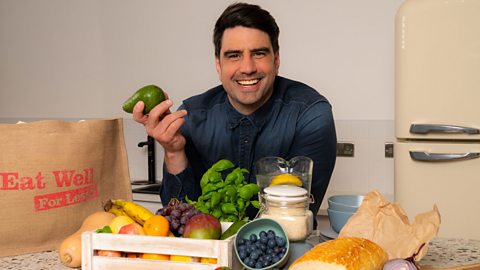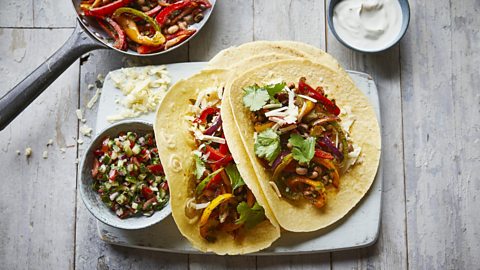Why are we cooking separate dinners for everyone?

Sharing a single meal around the dinner table, with everyone eating the same food, shouldn't feel old-fashioned. But a recent found that only 28% of households eat the same meal together regularly. The result is a bigger food bill, more food waste, more stress and valuable time spent in the kitchen.
The stress and costs could easily rise with the school holidays upon us ‚Äď with families now having to provide more meals at home.
Eat Well For Less? presenter Chris Bavin has come up with simple solutions.
Recognise that multiple dinners are problematic
‚ÄúI think everybody wants to please everybody,‚ÄĚ starts Chris, before explaining: ‚ÄúIt‚Äôs sometimes down to personal preference and fussy eating, but I think more commonly, it's now down to different dietary requirements‚Ķ ‚ÄĚ
There can be timing clashes from work and hobbies too, and with young families it's frequently due to children eating their dinner much earlier.
The problem is, Chris says, cooking multiple meals creates unnecessary stress ‚Äď and that‚Äôs before people have even considered the impact it‚Äôs having on their bank balance. ‚ÄúWe work with so many families and every time, you see that for the cooks in the house, it's a daily battle. People are worried but when you help them work through it, you see the stress being lifted from their shoulders.‚ÄĚ
Find common ground
Inevitably there are one or two dishes that everyone enjoys, says Chris. His advice is to see if those trusted components from one meal could be made in bulk and used on other nights.
For example, if If everyone likes the Yorkshire puddings from a roast dinner, then one evening a week you could have toad in the hole. Yorkshires freeze really well, so making a double batch means you can reheat them midweek. If roast chicken is a winner, how about making it go further by having leftover roast chicken fajitas?
Where mealtimes differ, or family members have different nutritional requirements, finding a unifying base recipe can be helpful. ‚ÄúMake one meal that can be taken into different directions,‚ÄĚ says Chris.
‚ÄúIn our house, my wife is vegetarian, my kids like to eat earlier and will have milder food than me and my wife. But, despite this, we can all eat the same meal. An example is a katsu curry. When I make the sauce it‚Äôs easily adaptable. I use vegetable stock, not chicken, so it‚Äôs vegetarian. The kids will have that when they‚Äôre back from school and then, later, we add more spice so it‚Äôs more suited for us.‚ÄĚ
10 customisable dinners
- Jacket potatoes with a batch-cook topping
- Quick curry sauce with your choice of meat and/or veg
- Quesadillas beans, cheese, leftovers all toasted
- Basic tomato sauce with your choice of add-ins
- Pancakes to fill with meat, cheese and vegetables
- Omelettes take minutes and each one can be different
- Pasta bake will hide a multitude of vegetables
- Bean tacos can take any number of toppings
- Easy pizza everyone's favourite made in minutes
- Halloumi wraps with fresh or grilled veg and hummus
Meal plan together
‚ÄúSit together and make a meal plan for the week. Getting everybody who‚Äôs going to be eating the meals involved is key,‚ÄĚ says Chris.
While it’s tempting for the people who make the food to just get on with the planning, family members won’t feel as invested, plus they’re more likely to reject what’s served up because they didn’t agree to it in the first place.
Chris continues: “Let them all have their say and let everybody choose a day as well. This helps when it comes to compromises through the week.
‚ÄúIf one child then says: ‚ÄėI don't want to eat this‚Ķ' you can reply with 'Yeah I know but it's [another family member‚Äôs] choice today you're getting your favourite tomorrow‚Äô.
‚ÄúIt helps when you‚Äôre trying to establish a bit of give and take,‚ÄĚ explains Chris.
Hand back control
‚ÄúI think when children are presented with a big plate of food, it can feel a bit daunting. Especially if they‚Äôre told things like ‚Äėyou're not having pudding until you finish that‚Äô or ‚Äėyou're not getting down until you finish‚Äô.
‚ÄúStraight away you've given them ‚Äď what they perceive is ‚Äď an insurmountable challenge. It‚Äôs almost a chore. With communal eating, you put the food in the middle of the table and say ‚ÄėI don't want you to eat everything. I don't even want you to try everything, just try some stuff‚Äô. You will be surprised; the children will put food on their plate by themselves because you've given them the control back.
‚ÄúI've seen it work so well in in lots of people's homes,‚ÄĚ begins Chris. ‚ÄúThe other benefit of that is there‚Äôs less food waste as anything leftover is untouched‚Ķ‚ÄĚ
Chris Bavin’s easy-win meals

Roast dinners
‚ÄúOn the show, the Sunday roast is something that lots of families say is popular and it‚Äôs the one meal that they will all sit down together and enjoy,‚ÄĚ says Chris. Combine familiar dishes like roasties, roast parsnips and gravy with more roast veg in a traybake that feels familiar.
Wrap it up
Wraps are great for communal eating, says Chris. ‚ÄúAnything that's got lots of individual components ‚Äď like fajitas or tacos are great. Because if someone doesn't like one thing, they can swap it out. They make for a fun meal as it‚Äôs a build-your-own food!‚ÄĚ
Curries
A great example of a ‚Äėbase‚Äô meal where you can adapt it to people‚Äôs tastes, explains Chris. ‚ÄúI would make a very mild curry sauce, halfway between a korma or a tikka masala for the family. The protein will be added later and individually, and then the spice level will be increased after I've portioned up the children's. One meal can be changed in so many ways. Just find those happy mediums!‚ÄĚ
Braised mince
‚ÄúIt‚Äôs really good for when you want to make one meal that can be taken into different directions,‚ÄĚ says Chris, before explaining: ‚ÄúOnce you've made up your simple mince in tomato sauce, that can be taken into almost limitless different directions - from chilli con carne to cottage pie, to burritos to bolognese. All those dishes can start with the same thing.‚ÄĚ
Fish cakes
These can be a great gateway dish, says Chris. They aren‚Äôt particularly scary or intimidating but the ingredients could lead to other dishes. ‚ÄúWork your way backwards from what you already eat, find those common themes and then look for variations of that. If everybody likes fish cakes, then fish pies aren‚Äôt a big leap from that or maybe a tuna pasta bake.‚ÄĚ
Don’t expect overnight success
Chris is the first to admit that when you see kids on the show suddenly being less fussy, it might be because they have a film crew in the house and it feels fun. ‚ÄėIt's the same as when your normally-fussy children go to someone else's house, and you‚Äôre told 'oh, they ate their dinner really well‚Äô‚ÄĚ.
“It's not easy. But every small change is a big step in the right direction. If you’re currently cooking four different meals every night and manage to reduce that to two, that's a 50 percent reduction. That's a lot!
“With Eat Well For Less? We aren’t judgemental, nor proclaim it's easy. If it was, we wouldn't be on series eight and it wouldn't be happening in every household up and down the country! You want to make small sustainable changes."